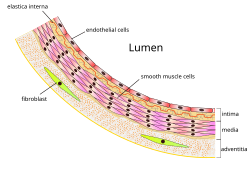Structure and Function of Endothelium
- The endothelium is a thin layer of single flat (squamous) cells that line the interior surface of blood vessels and lymphatic vessels.
- It forms an interface between circulating blood or lymph and the vessel wall.
- Endothelial cells control the flow of substances and fluid into and out of tissues.
- They regulate the passage of materials and the transit of white blood cells.
- Endothelial cells are involved in blood clotting, inflammation, and the formation of new blood vessels.
- They also regulate the constriction and enlargement of blood vessels, controlling blood pressure.
Endothelium and Blood Vessel Formation
- The endothelium plays a role in the formation of new blood vessels (angiogenesis).
- Angiogenesis is triggered by decreased tissue oxygen or insufficient oxygen tension.
- Various signals regulate angiogenesis, including integrins, chemokines, angiopoietins, and oxygen sensing agents.
- Angiopoietin-2 works with VEGF to facilitate cell proliferation and migration of endothelial cells.
- The general outline of angiogenesis involves activating signals, degradation of the basement membrane, and migration and proliferation of endothelial cells.
Endothelium and Clinical Significance
- Endothelial dysfunction is a hallmark for vascular diseases and a key early event in the development of atherosclerosis.
- Impaired endothelial function is seen in patients with coronary artery disease, diabetes mellitus, hypertension, hypercholesterolemia, and smokers.
- Endothelial dysfunction is predictive of future adverse cardiovascular events and is present in inflammatory diseases.
- Changes in endothelial function lead to endothelial dysfunction, characterised by inflammation and activation of endothelial cells.
- Endothelial dysfunction promotes accumulation of lipids, inflammation, and the formation of atherosclerotic plaques.
Endothelium in Cancer
- Endothelial cells in tumor vasculature have distinct morphological characteristics and molecular signature.
- They have a different origin compared to physiological endothelium.
- Biomarkers of tumor angiogenesis can be implemented using endothelial cells.
- New anti-angiogenic druggable targets can be identified through endothelial cells.
- Endothelial cells in tumor vasculature provide an opportunity for new therapeutic interventions.
Endothelium and Diet/Covid-19/Research
- A healthy diet abundant in fruits and vegetables improves endothelial function.
- A diet high in unhealthy foods adversely affects endothelial function.
- Endothelial cells in Covid-19 patients show viral elements and endotheliitis.
- Understanding endothelial dysfunction in Covid-19 can help improve patient management.
- Endothelial cells can be used in research for studying fibrinolysis and other aspects of endothelial function.
This article needs additional citations for verification. (April 2020) |
The endothelium (pl.: endothelia) is a single layer of squamous endothelial cells that line the interior surface of blood vessels and lymphatic vessels. The endothelium forms an interface between circulating blood or lymph in the lumen and the rest of the vessel wall. Endothelial cells form the barrier between vessels and tissue and control the flow of substances and fluid into and out of a tissue.
| Endothelium | |
|---|---|
 Diagram showing the location of endothelial cells | |
 Transmission electron micrograph of a microvessel showing endothelial cells, which encircle an erythrocyte (E), forming the innermost layer of the vessel, the tunica intima. | |
| Details | |
| System | Circulatory system |
| Location | Lining of the inner surface of blood vessels and lymphatic vessels |
| Identifiers | |
| MeSH | D004727 |
| TH | H2.00.02.0.02003 |
| FMA | 63916 |
| Anatomical terms of microanatomy | |
Endothelial cells in direct contact with blood are called vascular endothelial cells whereas those in direct contact with lymph are known as lymphatic endothelial cells. Vascular endothelial cells line the entire circulatory system, from the heart to the smallest capillaries.
These cells have unique functions that include fluid filtration, such as in the glomerulus of the kidney, blood vessel tone, hemostasis, neutrophil recruitment, and hormone trafficking. Endothelium of the interior surfaces of the heart chambers is called endocardium. An impaired function can lead to serious health issues throughout the body.
From endo- + thelium, as in epithelium.
endothelium (plural endothelia)